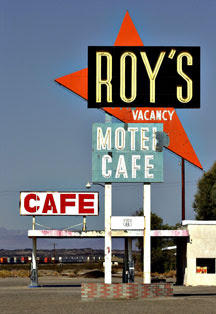Library to house desert history
 Mojave group gets grant for building
Mojave group gets grant for buildingBy Chuck Mueller, Staff Writer
San Bernardino Sun
GOFFS - A former railroad depot that six decades ago hosted thousands of troops training in the Mojave Desert is to be reborn as a library to house a rich collection of desert history.
Directors of the California Cultural and Historical Endowment have awarded a grant of $499,500 to build a library to hold the Mojave Desert Archives, gathered by Western historian Dennis G. Casebier during the past 50 years.
The archives, the single largest collection of historical material dealing with the Western migration and pioneering ventures in the Mojave, includes more than 6,000 volumes of published works, 50,000 photographs and 4,500 maps of the region dating to the pioneering quest for the West.
The collection is housed in various buildings at the 20-structure Goffs Cultural Center. The center includes the original Goffs School, which was built in 1914 and is now a museum, and a twice-moved dwelling constructed in 1927 that serves as a library.
It will take about two years to construct the library, which will be designed in the image of the historical Goffs railroad depot, which operated from 1902 to 1956. In the early 1940s, thousands of soldiers training in desert warfare arrived and departed from the depot, which was demolished in 1956, Casebier said.
The grant to the Mojave Desert Heritage Cultural Association, founded by Casebier and his wife, Jo Ann, in 1993, is one of 13 awarded out of 276 applications for funds through the endowment, supported by Proposition 40.
In 2002, California voters approved the Clean Water, Clean Air, Safe Neighborhood Parks and Coastal Protection Act, known as Proposition 40, to set aside $267 million for historical and cultural resource preservation.
Kevin Starr, California historian emeritus, said the endowment's mission is to document the contributions of the many groups of people who make up California. It also helps Californians to deepen their understanding of the state's history, its present society, and themselves.
"The receipt of this generous grant marks the first time we've gotten support from outside our own membership of about 800 people," Casebier said. "The bulk of the work at the Goffs Cultural Center ... has been done by volunteers from California, Arizona and Nevada."
Viewing the upcoming construction project, volunteer Chris Ervin said, "Now the work really begins."
Among the volumes in the collection at Goffs are originals of official reports of the 1853-54 Whipple expedition, which surveyed a route for a Pacific railroad across the Mojave.
"We also have the official reports and map of Edward Fitzgerald Beale, who brought camels to California from Texas in 1850," Casebier said.
"The collection includes everything related to the East Mojave, dating to 1850. There was nothing before that."
Casebier said the center acquired the volumes "one at a time and there is a story behind each one."
The volumes also include 2,000 loose subject files pertaining to individuals of interest and specific cultural sites. It also contains an extensive collection of old area newspapers, periodicals and pamphlets, and material culled from federal records in the National Archives.
"We also have compiled 700 oral histories," Casebier said. "We're constantly looking for volunteers to help us continue this important work, and are searching for desert old-timers to participate in our extensive oral history program."
Casebier, 72, a Kansan who served in the Marine Corps at Twentynine Palms for 22 years, later was employed as a Navy physicist working with guided missile systems in Corona. During visits to Washington, D.C., he frequented the Library of Congress and the National Archives, conducting research on the East Mojave.
After writing a book in 1970 about the Arizona territory, Casebier started Tales of the Mojave Road Publishing Co., which has produced 24 titles. Sixteen were authored by Casebier.
"In 1980, I started in earnest with the library collection," he said.
A year later, Casebier formed a volunteer group that continues today, called the Friends of the Mojave Road.
"We worked with the U.S. Bureau of Land Management to develop the Mojave Road and other historic trails into the back country," he said.
For this work, Casebier and the group received the bureau's highest national award for volunteer service.
Upon retiring in 1990, the Casebiers bought the old Goffs school and 113 acres around it, intent on opening a desert cultural center. Three years later, they helped found the nonprofit, tax-exempt Mojave Desert Heritage Cultural Association to take over the property.
"In 1998, Jo Ann and I deeded the school and the 1-acre school yard to the association, restoring the school to its 1914 condition," Casebier said. "In 2001, the school was listed on the National Register of Historic Places."
The Casebiers donated 70 acres of their property to the cultural association in late 2002.





